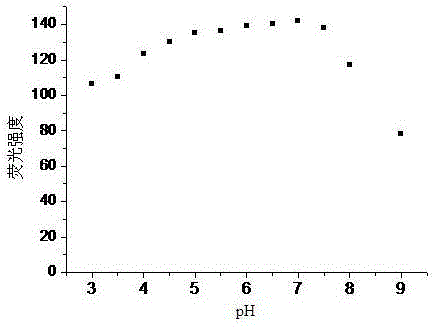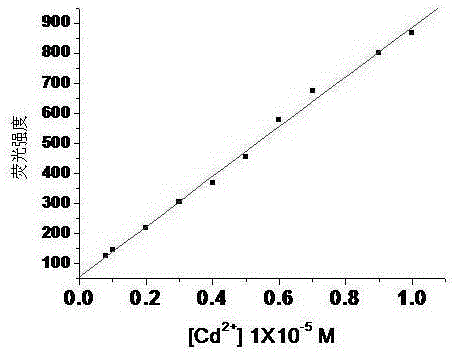Application of 8-hydroxyquinoline-7-salicylhydrazide acetal compound to cadmium ion fluorescent probe
A technology of aldehyde salicylic hydrazide and hydroxyquinoline, which is applied in the field of optical analysis and detection, can solve the problems of difficult absorption of cadmium, lack of iron or calcium, etc., and achieves the effects of good permeability and fast fluorescence response
- Summary
- Abstract
- Description
- Claims
- Application Information
AI Technical Summary
Problems solved by technology
Method used
Image
Examples
Embodiment 1
[0026] Optimization of Experimental Conditions
[0027] 1. Selection of probe molecule concentration
[0028] Increasing the concentration of probe molecules can increase the absorbance and fluorescence intensity, which is beneficial to improve the selectivity of the determination of metal ions and the linear range of the standard curve. However, when the concentration is too high, the fluorescence intensity of the blank will also increase with the increase of the probe molecule concentration, and if the concentration is too low, it will be difficult to detect the fluorescence absorption peak after adding ions. Considering the sensitivity and linear range of the method, the probe The concentration is chosen to be 1.0×10 -3 mol / L.
[0029] 2. Selection of buffer solution
[0030] Add 1mL of 4-hydroxyethylpiperazineethanesulfonic acid buffer solution to a 10mL colorimetric tube, and then add 0.01mL of the molar concentration to 1.0×10 -3 mol / L DMF-H of 8-hydroxyquinoline-7-a...
Embodiment 2
[0037]Add 1mL of 4-hydroxyethylpiperazineethanesulfonic acid buffer solution to multiple 10mL colorimetric tubes, and then add 0.01mL of the molar concentration to 1.0×10 -3 mol / L DMF-H of 8-hydroxyquinoline-7-aldehyde salicylhydrazide 2 O (DMF and H 2 The volume ratio of O is 1:99) solution, and then add different concentrations of cadmium ion solutions respectively, use deionized water to make the volume to 10mL, shake and mix for 20min, then measure the fluorescence intensity of each solution, the fluorescence intensity measurement condition is excitation narrow Slit 5nm, emission slit 10nm, excitation wavelength 369nm, emission wavelength 470nm, the fluorescence absorption peak at 470nm in the fluorescence absorption spectrum gradually increases with the increase of cadmium ion concentration, determine the quantitative relationship between fluorescence intensity and cadmium ion concentration and make a standard curve (Such as image 3 ), where the limit of detection (LOD...
Embodiment 3
[0041] Add 1mL of 4-hydroxyethylpiperazineethanesulfonic acid buffer solution to multiple 10mL colorimetric tubes, and then add 0.01mL of the molar concentration to 1.0×10 -3 mol / L DMF-H of 8-hydroxyquinoline-7-aldehyde salicylhydrazide 2 O solution, and then add the molar concentration of 1.0×10 -3 mol / L metal ion standard solution, dilute to 10mL with deionized water, shake well and measure the fluorescence intensity of each solution (such as Figure 4 ), the results show that when various metal ions of the same concentration interact with the probe molecule KXZ, only Cd 2+ and Zn 2+ The addition of the mixed system increases the fluorescence intensity at 470nm, while other metal ions interact with the probe molecule, compared with the blank sample, the fluorescence intensity does not change significantly, indicating that the probe molecule KXZ has the ability to recognize cadmium ions and zinc ions. Very good choice.
PUM
 Login to View More
Login to View More Abstract
Description
Claims
Application Information
 Login to View More
Login to View More - R&D
- Intellectual Property
- Life Sciences
- Materials
- Tech Scout
- Unparalleled Data Quality
- Higher Quality Content
- 60% Fewer Hallucinations
Browse by: Latest US Patents, China's latest patents, Technical Efficacy Thesaurus, Application Domain, Technology Topic, Popular Technical Reports.
© 2025 PatSnap. All rights reserved.Legal|Privacy policy|Modern Slavery Act Transparency Statement|Sitemap|About US| Contact US: help@patsnap.com



